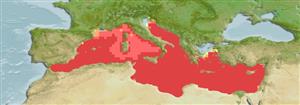Environment: milieu / climate zone / depth range / distribution range
Ecologie
marien; oceanodroom (Ref. 51243); diepte 0 - 200 m (Ref. 43). Deep-water; 46°N - 30°N, 6°W - 36°E (Ref. 43)
Mediterranean Sea: considerably abundant around Italy. No confirmed report from the Black Sea. No adults have been reported east of the Ionian Sea. Highly migratory species. Reportedly caught from the Aegean Sea (Pennetti, pers. comm.).
Grootte / Gewicht / Leeftijd
Maturity: Lm ? range ? - ? cm
Max length : 240 cm TL mannelijk / geslacht onbekend; (Ref. 4770); common length : 200 cm OT mannelijk / geslacht onbekend; (Ref. 43); max. gepubliceerd gewicht: 70.0 kg (Ref. 43)
This species is the most common istiophorid in the central basin of the Mediterranean and completes its life cycle inside this sea as far as is known to date. Probably swims in the upper 200 m water layer, generally above or within the thermocline. Travels in pairs, possibly corresponding to a feeding behavior. Feeds on fishes. Probably more widespread in the Mediterranean Sea and may have been identified as T. albidus by anglers and fishermen.
Levenscyclus en paargedrag
Maturiteit | Voortplanting | Paaien | Eieren | Fecunditeit | Larven
Winter and spring might not be an unreasonable hypothesis for the spawning season of this species.
Nakamura, I., 1985. FAO species catalogue. Vol. 5. Billfishes of the world. An annotated and illustrated catalogue of marlins, sailfishes, spearfishes and swordfishes known to date. FAO Fish. Synop. 125(5):65p. Rome: FAO. (Ref. 43)
Status op de Rode Lijst van het IUCN (Ref. 130435)
Gevaar voor de mens
Harmless
Gebruik door de mens
Visserij: van minder commercieel belang
Meer informatie
ReferentiesAquacultuurAquacultuurprofielKweeklijnenGeneticaElectrophoresesErfelijkheidZiektesVerwerkingNutrientsMassaconversie
Tools
Speciale rapporten
Download XML
Internetbronnen
Estimates based on models
Preferred temperature (Ref.
123201): 13.7 - 19.3, mean 15.3 °C (based on 121 cells).
Fylogenetische diversiteitsindex (Ref.
82804): PD
50 = 0.5630 [Uniqueness, from 0.5 = low to 2.0 = high].
Bayesian length-weight: a=0.00447 (0.00193 - 0.01034), b=3.14 (2.94 - 3.34), in cm total length, based on LWR estimates for this (Sub)family-body shape (Ref.
93245).
Trofisch niveau (Ref.
69278): 4.4 ±0.63 se; based on food items.
Weerstandsvermogen (Ref.
120179): laag, minimale populatieverdubbelingstijd 4,5-14 jaar (Assuming tmax>10).
Fishing Vulnerability (Ref.
59153): Very high vulnerability (90 of 100).
Nutrients (Ref.
124155): Calcium = 16 [7, 36] mg/100g; Iron = 0.474 [0.234, 0.985] mg/100g; Protein = 18.7 [17.4, 19.9] %; Omega3 = 0.216 [0.106, 0.456] g/100g; Selenium = 19.9 [7.1, 55.8] μg/100g; VitaminA = 4.5 [0.8, 26.0] μg/100g; Zinc = 0.217 [0.142, 0.343] mg/100g (wet weight);
